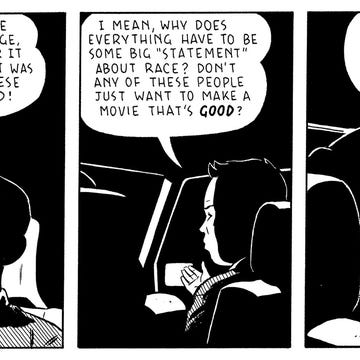Latinos make up close to 20 percent of the U.S. population (according to last year’s census data). One of the driving factors behind this large number was migration during the early 20th century—a migration that was influenced by the rule of former Mexican president Porfirio Díaz, the establishment of the Bureau of Investigations (which later became the FBI), and the actions of former U.S. president Theodore Roosevelt. If you find yourself unfamiliar with this historical account, take comfort in knowing that you are not alone.
I grew up in Southern California, which is home to more than 9 percent of the nation’s Hispanic population. Holding steadfast to my Mexican heritage while receiving an American education, I expected to be well versed in the history of both my countries. To my surprise, the California Book Club title this month, Bad Mexicans: Race, Empire, and Revolution in the Borderlands, by Kelly Lytle Hernández, opened my eyes to the reality that the historical relationship between Mexico and the United States remains significantly overlooked and underdiscussed.
“Mexican American history in general is not well-known in the United States,” Hernández told the Texas Standard. “It’s not part of the canon of U.S. history. And this story of the magonistas is typically tucked into the corners of Mexican American history.”
The magonistas were Mexican rebels who worked arduously to overthrow President Díaz, who held multiple terms in power and presented himself to the world as a leader aiming to uplift Mexico and advance industrialization. Yet, the facts reveal a different tale—a story of Díaz prioritizing the desires of American capitalists over the welfare of his own people.
In the 300-plus pages of Bad Mexicans, Hernández suggests that Mexico and the United States have been so intricately connected over time that it’s difficult to know where one ends and the other begins. One of the Bureau of Investigation’s first assignments from President Roosevelt was to hunt down the magonistas who had taken refuge in the States. The U.S. Departments of War, Treasury, and State also played a strong role in this task, and even the Postal Service found itself affected at one point. Hernández, a 2019 recipient of the MacArthur Fellowship, reframes our understanding of the details surrounding the United States’ historical relationship to Mexico, though she notes that Mexican scholars are well aware of this history. “The only thing I’m doing with this book,” she told the Los Angeles Times, “is taking everything and pivoting and positioning it within the context of U.S. history.”
If you ever feel disoriented while navigating the pages, don’t worry. This guide will help you locate the right years—allowing you to grasp the complex story behind the rise of the U.S. empire, our current immigration policy, and the ongoing challenges faced by Latinx communities today.
“I hope that this becomes an entry point for more readers across the United States to open up their lens to understand that Latinx histories are critical, central, and pivotal to the U.S. story,” she said to Democracy Now!
Bad Mexicans Timeline
- 1876: President Porfirio Díaz takes power and begins his 35-year reign.
- 1888: President Díaz, amid public unrest, removes the constitutional ban on reelection.
- 1900: Antonio Horcasitas and Ricardo and Enrique Flores Magón begin publishing their newspaper, Regeneración, which circulated revolutionary ideas; this comes 24 years into President Díaz’s rule.
- 1901: During the Liberal conference, Ricardo Flores Magón utters the words that ignite the Mexican Revolution, proclaiming, “The Díaz administration is a den of thieves!” After the conference, the newspaper becomes bolder than ever before.
- 1904: Ricardo and Enrique Flores Magón and Juana Sarabia flee to Texas. In that same year, an armed man breaks into their offices and attempts to stab Ricardo. The Regeneración offices move to St. Louis, Missouri.
- 1906: The magonistas launch a raid on Jiménez, Mexico, from Texas, destabilizing Díaz’s regime and prompting people to question whether Díaz has the ability to quell the uprising.
- 1907: Díaz’s agents manage to infiltrate the Postal Service, and it is through Ricardo Flores Magón’s letters that he is eventually traced to Los Angeles, where he has been publishing Regeneración under a new name, Revolución. Consequently, he is apprehended and imprisoned by a detective employed by a Mexican governor and Los Angeles police officers.
- 1908: The Bureau of Investigation is established, and one of its first assignments is finding Práxedis Guerrero, a magonista closely involved with the Partido Liberal Mexicano, or the PLM.
- 1910: As Francisco Madero, a landowner, and the Anti-Reelectionist Party gain momentum, they emerge as formidable opponents to Díaz’s rule. Simultaneously, ongoing hearings serve to weaken support for Diaz’s regime.
- 1911: The Battle of Ciudad Juárez takes place. During this year, Díaz and his vice president, Ramón Corral, flee to France; Madero is elected president.
- 1913: Madero is shot dead.
- 1915: El Plan de San Diego is discovered and triggers a manhunt. The plan was drafted by Mexican rebels who wanted to seize California, Arizona, New Mexico, and Texas from the United States in response to a brutal campaign against South Texas Mexican communities by the Texas Rangers and others hoping to gain control of land and resources. The result of the manhunt is the death of at least 300 Mexicans and Mexican Americans in a tragic and bloody episode.•
Join us on September 21 at 5 p.m., when Hernández will appear in conversation with a special guest and California Book Club host John Freeman to discuss Bad Mexicans. Register for the Zoom conversation here.
POLITICS OF STATE VIOLENCE
Poet and critic Diego Báez considers the evolution of his political thought after reading Bad Mexicans. —Alta
Q&A WITH KELLY LYTLE HERNÁNDEZ
Alta Journal books editor David L. Ulin discusses Hernández’s motivation for writing Bad Mexicans with her. She explains, “I wanted to recapture that dynamic, that dimension, the idea that migrant workers, miners, and cotton pickers then and now are integral intellectuals and political actors who can advance justice for all of us.” —Alta
RE-CREATING YOUNG ADULTHOOD
Cousins Jillian and Mariko Tamaki, known for This One Summer, have written their first graphic novel for adults, Roaming, about 19-year-old friends. Ulin writes that it “is both universal and highly personal.” —Alta
WRITERS AND MACHINES
Poets Christopher Soto and Jackie Wang discuss the effects of AI on literary production and what’s on the horizon. —Los Angeles Times
SERVING THE COMMUNITY
Last year, two friends opened a new bookstore, Wanderlust Book Lounge, in Bothell, Washington. It has a popular book club program. —Seattle Times
REIMAGINING THE COAST
Rosanna Xia’s California Against the Sea: Visions for Our Vanishing Coastline investigates competing visions for the coastline in the face of rising sea levels. —Los Angeles Times
Alta’s California Book Club email newsletter is published weekly. Sign up for free and you also will receive four custom-designed bookplates.



















